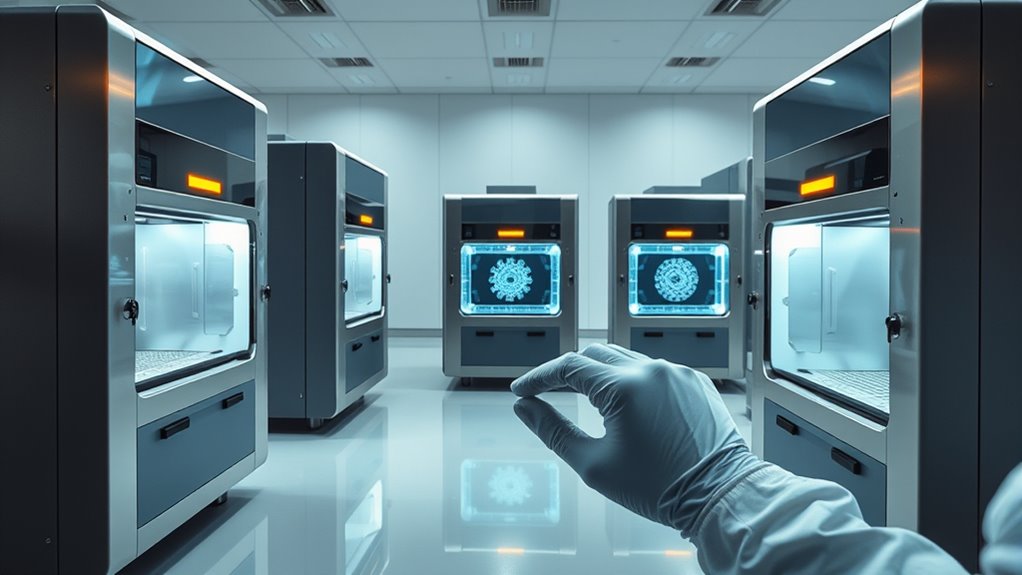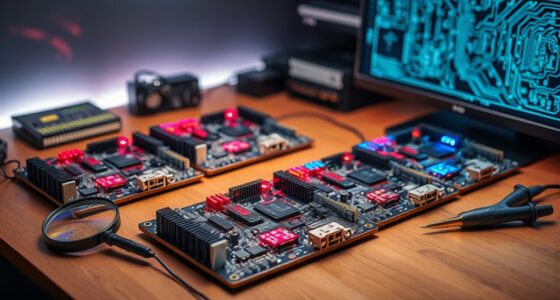If you’re looking for the top high-resolution nanolithography systems of 2025, I can guide you through the best options for precision nano fabrication. These systems feature advanced capabilities like sub-10 nanometer resolution, high patterning accuracy, and fast throughput speeds. They also offer robust compatibility and environmental controls essential for consistent results. Keep exploring further, and you’ll discover detailed insights on how to choose the ideal system for your needs.
Key Takeaways
- Top systems achieve sub-10 nanometer resolution using EUV, X-ray, or electron beam technologies for atomic-scale patterning.
- Compatibility with existing hardware, substrates, and design tools ensures seamless integration and operational efficiency.
- High throughput speeds exceeding 1000 cm²/hr enable efficient large-area nanofabrication without compromising precision.
- Precise beam focusing, calibration, and environmental controls are essential for consistent, high-fidelity nanoscale patterning.
- Skilled operation and rigorous maintenance are critical to maintaining system stability and achieving optimal high-resolution results.
TBS2603au NDI|HX2 Video Encoder/Decoder – HDMI USB Recorder
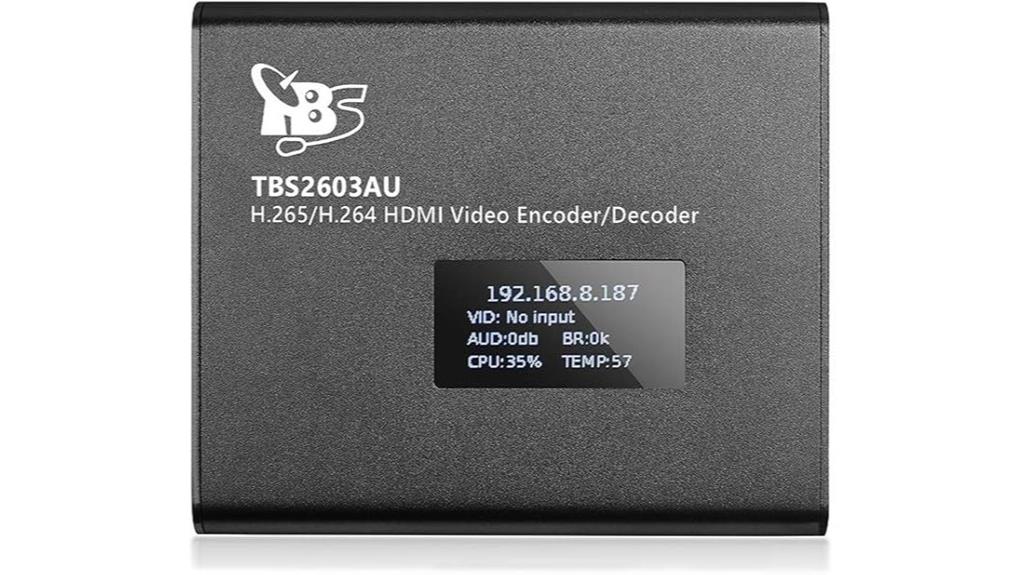
Are you looking for a versatile high-resolution video encoder and decoder that seamlessly integrates with professional broadcasting and streaming setups? The TBS2603au NDI|HX2 offers just that. It supports multiple streaming protocols like RTSP, RTMP, SRT, and NDI|HX, ensuring smooth transmission over LAN or WAN. It can decode HDMI, IP streams, or NDI|HX, with support for H.265 and H.264 formats for high-quality playback. Plus, it records via USB in formats like MP4 and MKV. With features like logo insertion, text overlays, mosaics, and ROI customization, it’s perfect for professional video production and live streaming environments.
Best For: professional broadcasters, live streamers, and video production teams seeking versatile high-quality encoding, decoding, and recording solutions.
Pros:
- Supports multiple streaming protocols including NDI|HX, RTSP, RTMP, and SRT for flexible network integration.
- Decodes high-quality video formats like H.265 and H.264, ensuring compatibility and efficient playback.
- Offers comprehensive overlay features such as logo insertion, text, mosaics, and ROI for customized live production.
Cons:
- May require a compatible network environment to fully leverage NDI|HX streaming capabilities.
- Limited to HDMI and IP stream inputs, which might necessitate additional adapters for other sources.
- Advanced features and multi-format recording may demand higher storage and processing resources.
NOYAFA NF-521 Infrared Thermal Imager
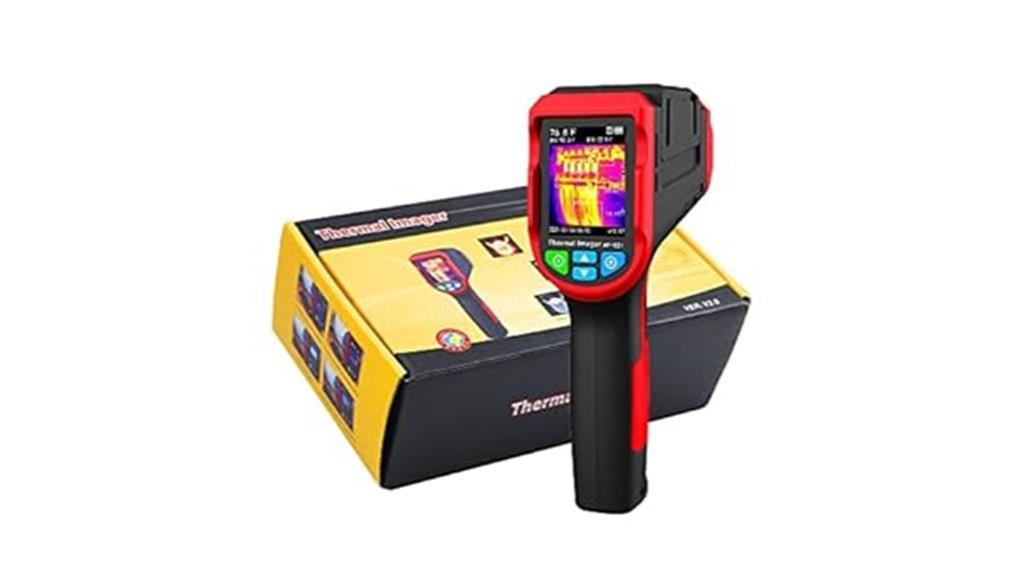
The NOYAFA NF-521 Infrared Thermal Imager stands out for professionals who need high-resolution thermal imaging combined with versatile visualization options. This handheld, industrial-grade device offers a 2-megapixel white lens with 32 x 32 resolution, ensuring detailed thermal detection. Its 2.4 TFT LCD display provides clear visualization in multiple modes, including infrared, edge detection, and dual light fusion. With a temperature range from -10°C to 400°C and various palettes, it’s perfect for applications like fire protection, electronics, and industry. Data storage via micro SD and USB export makes analysis straightforward. It’s a practical, user-friendly tool for precise thermal inspections.
Best For: professionals in industrial, electrical, fire safety, and inspection fields seeking detailed thermal imaging for precise diagnostics.
Pros:
- High-resolution 2-megapixel imaging with detailed thermal detection
- Versatile imaging modes including infrared, edge detection, and dual light fusion
- Data storage via micro SD and USB export for comprehensive analysis
Cons:
- Some units may lack charging capabilities, limiting portable use
- Resemblance to a child’s toy may affect perceived professionalism
- Limited resolution (32 x 32) may not capture extremely fine thermal details
Business 3-Phase Energy & Solar Monitor
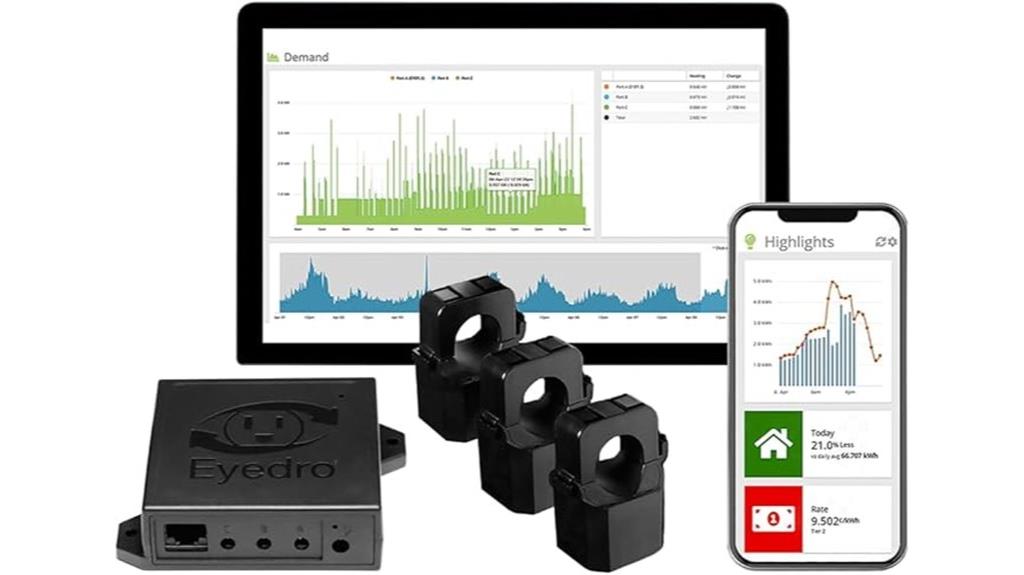
Looking for a reliable way to monitor your energy consumption and maximize solar savings? The Business 3-Phase Energy & Solar Monitor (Model E5B-EW-E3) offers extensive grid, solar, and net metering monitoring for three-phase systems. It supports multiple voltage configurations and connects via WiFi or Ethernet for easy, non-invasive installation. The device tracks power in real-time, including Watt-Hours, Amps, Volts, and costs, while the MyEyedro cloud platform provides detailed analytics, alerts, and automated reports. Perfect for businesses and landlords, it helps optimize energy use, identify phantom loads, and improve efficiency—making it a valuable tool for maximizing solar benefits.
Best For: businesses, landlords, and energy-conscious users seeking detailed energy monitoring, solar optimization, and cost management for three-phase electrical systems.
Pros:
- Supports multiple voltage configurations and easy non-invasive installation with split core sensors.
- Includes free access to MyEyedro cloud platform with real-time analytics, automated reports, and alerts.
- Capable of monitoring power in Watt-Hours, Amps, Volts, and costs, helping identify phantom loads and peak demands.
Cons:
- Some users experience WiFi connectivity issues; Ethernet connection recommended for better reliability.
- Documentation can be limited, making setup more challenging for some users.
- Not compatible with certain systems such as 208V single-phase in specific locations like NYC.
AURSINC TinySA Spectrum Analyzer with 32GB Card
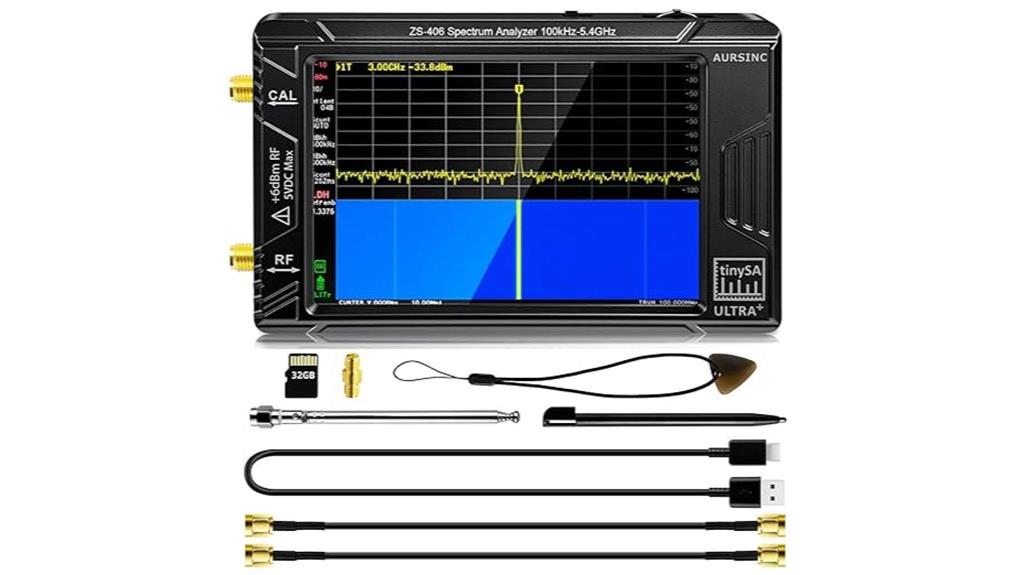
For professionals requiring portable and versatile spectrum analysis, the AURSINC TinySA Ultra+ ZS406 stands out with its built-in 32GB micro SD card, enabling on-site data storage and sharing without relying on external devices. Its HW V0.4.6 upgrade, 4.0-inch touchscreen, and broad frequency range (100kHz-5.4GHz, up to 6GHz in ultra mode) make it highly adaptable for field testing. It functions as both a spectrum analyzer and signal generator, offering precise measurements with adjustable RBW filters and excellent phase noise performance. The device’s compact design, long battery life, and seamless connectivity guarantee it’s a reliable choice for detailed spectrum analysis anywhere.
Best For: professionals and technicians seeking a portable, versatile spectrum analyzer with on-site data storage and comprehensive measurement capabilities.
Pros:
- Built-in 32GB micro SD card for easy on-site data storage and sharing
- Broad frequency coverage from 100kHz to 5.4GHz, with ultra mode extending up to 6GHz
- Dual functionality as both spectrum analyzer and signal generator, enabling versatile testing
Cons:
- Limited battery life of around 3 hours per charge may require additional power sources for extended use
- The device’s advanced features and controls may have a steep learning curve for beginners
- External accessories like SMA cables and antennas are required for full functionality, adding to setup complexity
Infinity-Corrected Trinocular Compound Microscope with 24MP Monitor
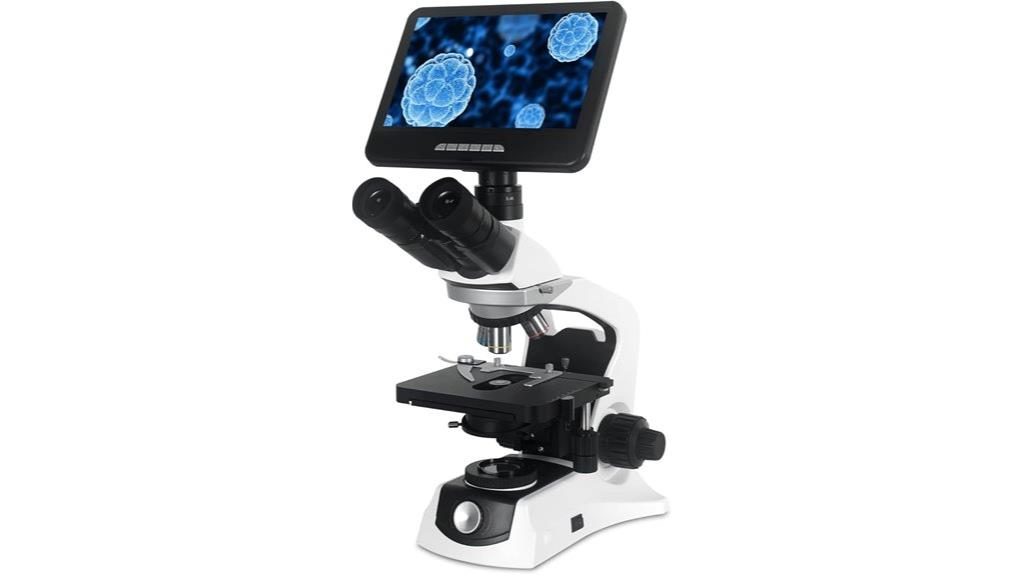
If you’re seeking a microscope that combines high-resolution imaging with user-friendly digital integration, the Infinity-Corrected Trinocular Compound Microscope with 24MP Monitor stands out as an ideal choice. It offers 40-1000X magnification with high-clarity optics, parallel optical paths, and a large mechanical stage for precise sample observation. The 24MP monitor supports real-time 4K imaging, captures photos and videos at up to 2880×2160 resolution, and includes measurement software for detailed analysis. Despite some concerns about build quality, users praise its versatility, image clarity, and ease of use, making it suitable for research, education, and professional applications.
Best For: educators, researchers, and hobbyists seeking high-resolution, easy-to-use digital microscopy with versatile imaging and analysis capabilities.
Pros:
- Offers 40-1000X magnification with high-clarity optics and parallel optical path for sharp images
- Features a 24MP monitor supporting real-time 4K imaging, photo/video capture, and measurement software for detailed analysis
- Durable construction with a large mechanical stage and precise focus controls suitable for professional and educational use
Cons:
- The screen’s plastic build can feel flimsy and less durable over time
- Some users report the head movement feels rickety, affecting stability during observation
- Illumination may be less bright than expected, requiring adjustments for optimal viewing
Factors to Consider When Choosing High-Resolution Nanolithography Systems
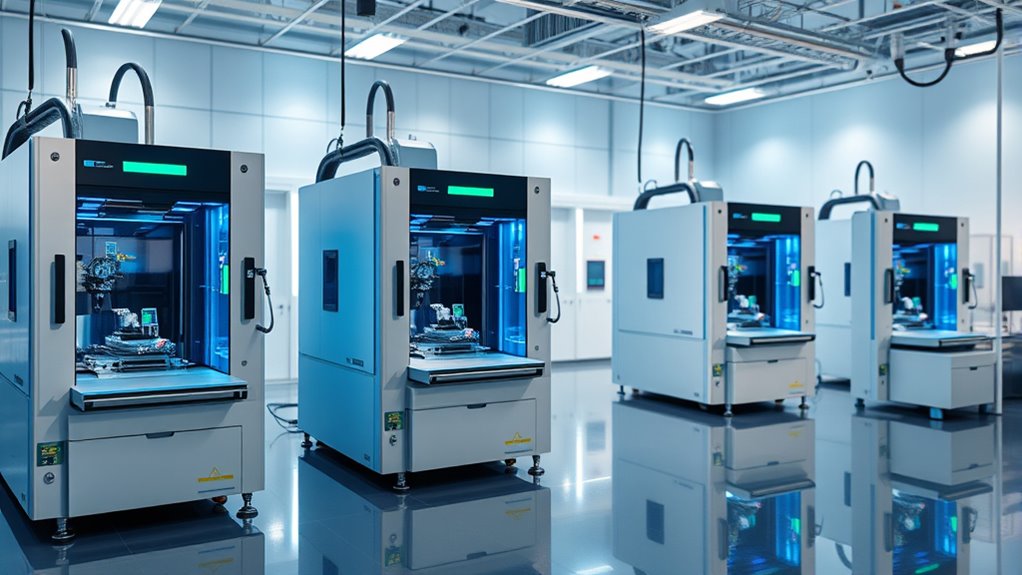
When selecting a high-resolution nanolithography system, I focus on key factors like resolution capabilities and patterning precision to guarantee it meets my project needs. I also consider system compatibility and throughput speed to balance performance with efficiency. Finally, I evaluate operational complexity to choose a solution that I can effectively manage and maintain.
Resolution Capabilities
Achieving high-resolution in nanolithography systems depends on several critical factors that influence the level of detail attainable. The primary determinant is the wavelength of the exposure source—shorter wavelengths like EUV or X-ray enable finer features, often below 10 nanometers. Advanced systems leverage electron beam or ion beam techniques, pushing resolution into the single-digit nanometer range. Precision in resolution also hinges on the stability, accuracy, and calibration of the system’s positioning and scanning mechanisms, ensuring consistent patterning at atomic scales. Additionally, material properties and resist sensitivity markedly impact achievable resolution; selecting appropriate resists and optimizing process parameters prevent pattern degradation. Together, these factors define the system’s ability to produce intricate, high-fidelity nanostructures essential for cutting-edge applications.
Patterning Precision
Patterning precision in nanolithography systems hinges on the minimum feature size they can reliably produce, often reaching below 10 nanometers with advanced techniques. Achieving this level of detail depends heavily on the stability and accuracy of the stage or substrate positioning system, which guarantees consistent and high-fidelity patterns. The resolution of the beam—electron or ion—sets the smallest features possible, with higher-resolution systems enabling finer patterning. Precise control over beam focus, alignment, and exposure parameters is essential to maintain feature dimensions and prevent distortions. Additionally, environmental factors like vibrations, temperature fluctuations, and electromagnetic interference can compromise accuracy. To guarantee ideal patterning, rigorous isolation and environmental controls are necessary, making these factors vital considerations when selecting a nanolithography system.
System Compatibility
Selecting a high-resolution nanolithography system requires careful attention to compatibility with your existing hardware and software infrastructure. First, confirm the system supports your current sources, whether EUV, deep UV, or electron beam, to avoid costly upgrades. Check that it uses standard file formats and communication protocols that match your lab’s workflows, facilitating smooth integration. Compatibility with your operating systems and design tools is essential for seamless operation and data exchange. Additionally, verify the system can handle your substrate sizes and materials without modifications, saving time and resources. Finally, assess whether calibration and maintenance procedures align with your team’s technical capabilities and available resources, ensuring reliable performance and minimizing downtime. Proper compatibility streamlines your workflow and optimizes system utilization.
Throughput Speed
When choosing a high-resolution nanolithography system, throughput speed plays a crucial role in meeting production demands, especially for large-scale applications. Faster systems can process larger sample areas more quickly, boosting overall productivity and reducing bottlenecks. Throughput is typically measured in square centimeters per hour (cm²/hr), with cutting-edge models surpassing 1000 cm²/hr. However, increasing speed must be balanced with maintaining resolution and accuracy to prevent quality loss. Factors like scanning speed, pattern complexity, and system automation influence throughput performance. Selecting a system with ideal throughput ensures efficient manufacturing without sacrificing the precision necessary for nanoscale features. Ultimately, understanding these dynamics helps in choosing a system that aligns with both production volume and quality standards.
Operational Complexity
High-resolution nanolithography systems are inherently complex, often requiring specialized training to operate effectively. Managing precise alignment, calibration, and maintenance can substantially increase operational challenges. Each step—from substrate preparation to exposure and development—demands technical expertise to ensure accuracy and consistency. Advanced features like multi-beam or multi-patterning techniques add layers of intricacy, requiring users to master additional operational procedures. Furthermore, environmental controls such as vibration isolation and temperature stability are critical for reliable results, making system operation even more demanding. These factors mean that personnel need thorough training and experience to optimize performance. When selecting a system, I recommend considering how manageable its operational complexity is, especially in relation to your team’s skill level and available support infrastructure.
Cost Effectiveness
Considering the operational complexity of nanolithography systems, it’s just as important to evaluate their cost effectiveness to make a smart investment. I analyze initial purchase prices alongside ongoing costs like maintenance, consumables, and necessary upgrades to guarantee the system remains affordable over its lifespan. I also compare throughput and resolution capabilities to confirm I get high-quality results without overspending. Energy efficiency is another key factor, as lower power consumption reduces long-term operational costs and environmental impact. I evaluate the system’s cost-to-performance ratio, making sure advanced features justify the investment compared to alternatives. Ultimately, I consider the availability and costs of technical support, training, and software updates, which substantially influence overall value and ease of long-term operation.
Maintenance Requirements
Maintaining high-resolution nanolithography systems requires careful attention to their specific upkeep needs, as neglecting routine maintenance can compromise patterning accuracy and increase downtime. Regular calibration and cleaning of optical components are essential to guarantee precision. Some systems demand scheduled maintenance of laser sources, including power checks and replacing consumables like filters or mirrors. Environmental controls—such as stable temperature, humidity, and vibration isolation—are crucial for consistent operation and can reduce maintenance frequency. Routine software updates and system diagnostics help prevent unexpected failures and keep performance ideal. Proper handling and storage of substrates and consumables also extend equipment lifespan, minimizing repairs or replacements. Considering these maintenance factors when choosing a system ensures reliable performance and reduces long-term operational costs.
Frequently Asked Questions
How Do Nanolithography Systems Impact Future Nanoelectronics Development?
Nanolithography systems will revolutionize future nanoelectronics by enabling us to create smaller, more efficient components with incredible precision. I believe they’ll drive innovation in faster, more powerful devices, and open doors to new applications like quantum computing. With advancements in resolution and scalability, I’m excited about how these tools will shape the next generation of electronic devices, making them smarter, more compact, and energy-efficient.
What Are the Environmental Considerations for High-Resolution Nanolithography?
I believe environmental considerations are essential in high-resolution nanolithography. I’ve found that the process often uses hazardous chemicals and consumes significant energy, leading to pollution and waste. To minimize impact, researchers are exploring greener materials and more energy-efficient methods. It’s imperative we prioritize sustainability, ensuring these advanced systems advance technology without harming our planet. Responsible practices can help balance innovation with environmental stewardship.
How Do User Skill Levels Affect System Performance and Outcomes?
Your skill level really impacts the system’s performance and outcomes. When I’m well-trained, I can optimize settings, troubleshoot issues quickly, and achieve precise results. Conversely, if I lack experience, mistakes happen more often, leading to lower resolution or inconsistent patterns. Continuous learning and practice are essential for maximizing system capabilities, ensuring I produce high-quality nanostructures efficiently. The more I refine my skills, the better my fabrication results become.
What Maintenance Routines Ensure System Longevity and Accuracy?
Did you know that regular maintenance can extend a nanolithography system’s lifespan by up to 30%? I recommend daily cleaning of optical components, weekly calibration checks, and monthly thorough inspections of the vacuum and laser systems. Keeping a detailed maintenance log helps track issues early. Consistent routines like these guarantee your system stays precise, reliable, and ready for high-resolution fabrication, saving you time and costly repairs down the line.
Are There Emerging Technologies Expected to Surpass Current Nanolithography Systems?
Emerging technologies like extreme ultraviolet (EUV) lithography and directed energy deposition are poised to surpass current nanolithography systems. I believe these innovations will offer even higher resolution, faster processing speeds, and greater versatility. As technology advances, I stay excited about integrating these new methods into my workflows to achieve more precise and efficient nano fabrication, pushing the boundaries of what’s possible in this rapidly evolving field.
Conclusion
Choosing the right high-resolution nanolithography system isn’t just about precision; it’s about balancing power with finesse. While some systems boast incredible detail, others shine in ease of use. Think of it like comparing a high-end camera to a versatile smartphone—each has its strengths. Ultimately, your choice should align with your specific needs, blending cutting-edge technology with practical usability, so you can push the boundaries of nano fabrication without missing a beat.
